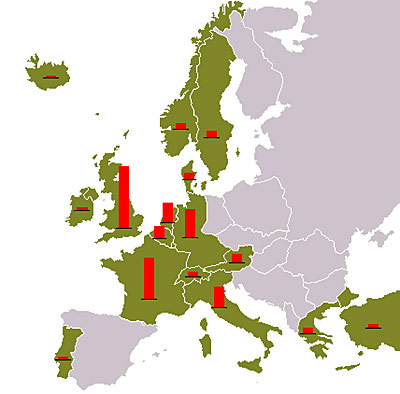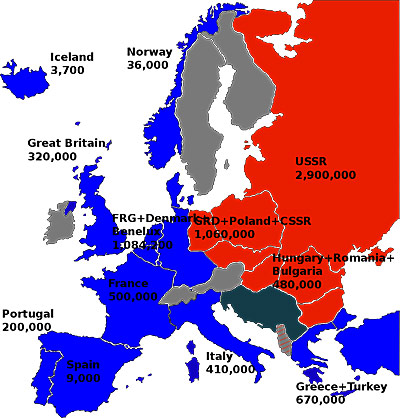
Unit 5: Crisis and Change
Lesson H: From Hot to Cold War
Activity 2: East vs West - NATO and the Warsaw Pact
After World War II, the U.S.S.R. and the U.S. had parted ways based on mutual suspicions of the actions and intentions of the other. A major objective of the United States was to contain the expansion of communist ideas and the Soviet government. Stalin and the U.S.S.R. repeatedly pursued aggressive policies of expansion that provoked the U.S. and the Western, democratic world.
In addition to the actions of the individual countries of the U.S.S.R. and the U.S., each of these countries contributed to and shaped international agreements around economic ideology, foreign policy, and national security that alienated the other superpower. The world was effectively divided into two camps, or the East and the West. In Europe, at least, this division largely followed the same lines as the countries that did and did not receive U.S. aid under the Marshall Plan.
Directions: Study the map of Europe noting which countries are allied with the United States through the Marshall Plan and which countries are more allied with the U.S.S.R. Note that Spain is not aligned with the U.S.S.R. even though it was not a recipient of Marshall Plan aid.

Map of Cold-War Era Europe; Countries that Received Marshall Plan Aid are Shown
in Green with the Red Columns Indicating the Relative Amount of Total Aid Per Nation. [1]
Two international military alliances formalized the post-war division of the world. One of these was NATO or the North Atlantic Treaty Organization, which was a collective security system intended to offset Soviet forces through the use of both conventional armies and nuclear weapons. The Berlin Blockade was the catalyst for the formation of NATO.
The other was the Warsaw Pact. Although standing in opposition to each other for nearly 40 years, the NATO and the Warsaw Pact member countries in Europe never directly waged war against each other. Nevertheless, the U.S. and U.S.S.R. and their respective allies implemented strategic policies aiming to contain each other’s spread in Europe, while also working and fighting for greater influence on the international stage.
![]() Directions: Read the brief introductions to the Warsaw Pact and NATO. Then, using what you know about these two, sort out the list of facts out for each of these international military agreements. Use the buttons provided to check the latest move or, when you are done, check the whole question. Use the feedback to confirm your understanding of the differences between these two major institutions of the Cold War.
Directions: Read the brief introductions to the Warsaw Pact and NATO. Then, using what you know about these two, sort out the list of facts out for each of these international military agreements. Use the buttons provided to check the latest move or, when you are done, check the whole question. Use the feedback to confirm your understanding of the differences between these two major institutions of the Cold War.
Directions: Confirm your understanding of the Warsaw Pact European countries and those engaged in NATO by reviewing this map showing the distribution of powers between member states of NATO and the Warsaw Pact (in 1973).

Distribution of Powers Between Member States of NATO and Warsaw Pact in 1973 [2]
Page Notes:
[1] Source: This map from http://en.wikipedia.org/wiki/File:Marshall_Plan.png is licensed under Creative Commons Attribution ShareAlike 3.0 license. Attribution: Paris 16.
[2] Source: This image from http://en.wikipedia.org/wiki/File:NATO_Warsaw_Pact.svg is in the public domain.

